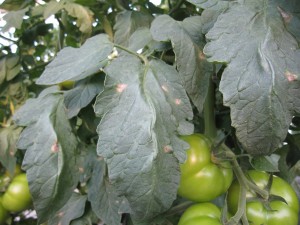Basics Information | Advanced Information | Diagnostic Information
Tomato Diseases | Powdery Mildew
Powdery Mildew
Identification
Leaves:
- Symptoms differ for each species of powdery mildew.
- A flat white moldy growth develops on the leaves.
- Bright yellow or green irregular spots form on the upper sides of leaves from Leveillula taurica infection, and then sometimes develop into necrotic lesions surrounded by yellow circles.
- A white mold develops on the undersides of the leaves from Leveillula taurica infection.
- White or grey splotches form on the upper sides of leaves and progress to the stems from Oidium neolycopersici.
- Rapid defoliation.
Fruits:
- Fewer and smaller fruits.
- Some fruits develop bright yellow spots.
- Fruits are unaffected from Oidium neolycopersici infection.
Favorable Environmental Conditions
- During the infection period, mild temperatures are more favorable.
- High relative humidity is conducive to colonization of the plant.
- Spore germination occurs from 50°F to 98°F, but the optimal temperature is about 70°F, and optimal relative humidity is 75 – 85%.
Often Confused With
- Leaf mold
- Botrytis grey mold
- Early blight
Scouting Notes
- Look on the upper or undersides of leaves for yellow spots or white moldy growth.
- Infected leaves should be removed and destroyed to prevent spread of powdery mildew.




